My Radical Approach to Class Management
David Finkle is a public school teacher in central Florida.
Click on any strip in this post to enlarge it!
When I began my teaching career, many of my classes were just like the comic strips above: LOUD.
My classes were somewhat out of control, to say the least. I took classroom management workshops to learn to control my students’ behavior, but much of what I heard at them felt wrong. I talked to other teachers, and sadly, much of what I heard from them sounded wrong, too.
Have a rule for everything. Enforce those rules with swift, sure consequences. Don’t give an inch. Don’t smile until after winter break.
In my comic strip, Mr. Fitz, the Mrs. Paquetts character is based loosely on any number of teachers I’ve encountered over the years whose approach to classroom management is, quite frankly, being mean.
In my experience, a class powered by fear is not focused on learning, but on compliance. And some of these teachers were even mean to their fellow teachers (including me) if they thought we weren’t measuring up to their discipline standards.
On the other hand, I also met teachers who tried to play the Nice Teacher game. I agree that we should be listening to our students and trying to understand them, but I also saw students take advantage of them.
I also encountered the positive reinforcement of bribery: the teachers who use treats and rewards of all kinds to motivate kids to behave. Mr. Pardee in my comic strip is an over-the-top version of that approach.
But seeing what other teachers did and not finding their approaches satisfactory didn’t leave me with a solution…
It left me with a sinking feeling.
Force-feeding, sweet-talking and bribes
Underneath all of these schemes, positive and negative, lurked the idea that education was this horrible thing we were trying get our students to take against their wills, and they either needed to be force-fed, sweet-talked, or bribed.
There had to be a better way. I just didn’t know what it was.
But then a student invited me to our school’s band and chorus concert. I went to the concert, and on that fateful night, I had a revelation.
I changed my approach. I stopped shouting. I took down my rules. Instead of struggling to start class, I just waited for them to quiet down, just see what would happen. They eventually quieted down on their own…


I was on the right track, but I wondered how I might start a new school year with this approach.
Then I read Alfie Kohn’s book Beyond Discipline: From Compliance to Community and realized that I needed to go even further, be even more deliberate about my new way of running my classroom.
What I eventually hit upon was starting on day one with their first writing assignment. I asked students in all my classes to write about the best class and worst class they had ever taken – and to explain what made them best and worst.
Although some students were a bit resistant (like Rufus in the strip above), most students dove right in and had a lot to say. (I asked them to use fake names for any teachers they were going to complain about, though real names were fine for their favorite teachers.) They were quite opinionated.
I had them share their journals in their small groups to start building a class community, and then we had a spirited all-class discussion, listing the traits of good classes and bad classes on a T-chart.
The list of “worst class” traits also included things like being too busy to talk to students, always being on their phones (!), and not giving feedback fast enough. I even got them to agree that students could ruin a class too, by blurting out, having side conversations, fighting, throwing things, and being rude.
We then developed a list of behaviors that lead to a “best class.” Interestingly, the list was generally the same for teachers and for students – things like paying attention, having manners, engaging in the learning. And almost always, it boiled down to everyone, teachers and students, being in the room to make learning happen.
If everyone is there to learn, there isn’t much need for rules to haggle over. Instead, everything becomes a question of “Is it helping us all learn?”
Our class-made rubric lets us rate the day
Once we had our “best class” list done, we developed an informal class rubric so we could rate how the class went each day.
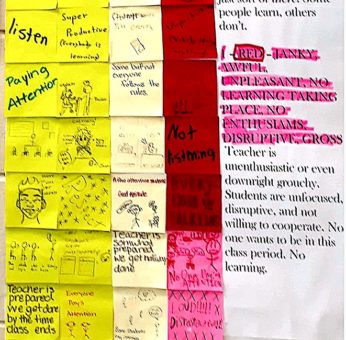
The class usually assigns names to a great, average, or not-so-great class period, things like Uber-Meh-Yuck or Awesome-Average-Arg!. A great class period is not a compliant class, but an enthusiastic engaged one.
At the beginning of the year, we rate the class at the end of each period. The class consensus always matches my rating. (We know, don’t we?) As the year goes on and we are consistently rating ourselves Stupendous, the ratings don’t matter any more. The fact that the class runs on a different vibe is what matters.
My collaborative approach to discipline may sound too good to be true. But it’s still working, eight years into the experiment. Some classes respond immediately; some need more time to adjust to the paradigm shift. But in the end, it nearly always works. I have not written a discipline referral for anything other than a hall fight for most of a decade.
And aside from the benefits of making my life easier and my class a place of true collaboration, I also think that running my class as less of a totalitarian state and more a place where everyone works for the common good is an investment in our collective future.
David Lee Finkle has been teaching secondary students in Florida for almost 30 years. He currently teaches Creative Writing and English Language Arts. Finkle also teaches fiction writing at Stetson University’s HATS program, leading students to write collaborative novels in a week.
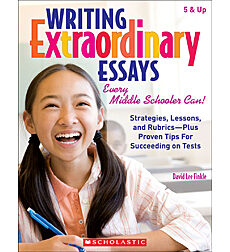
See another recent MiddleWeb post by David Finkle: Freeing Students to Write What They Know.



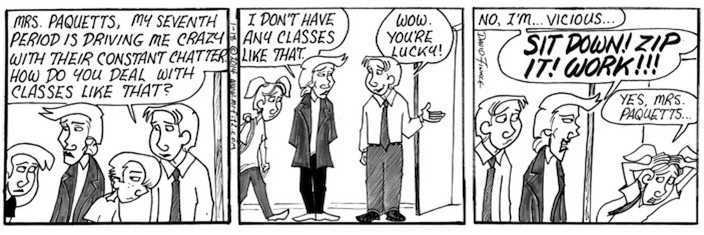
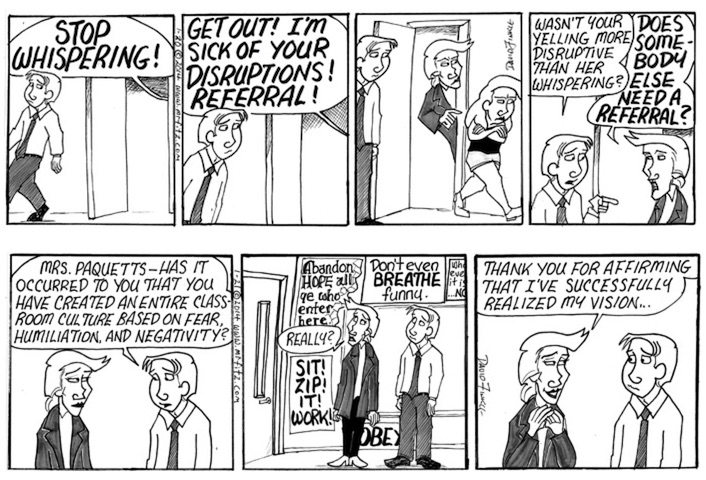





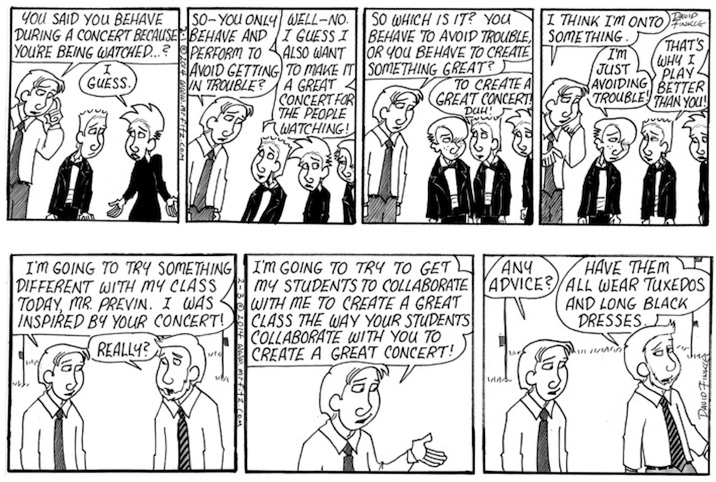








































David, your article made me wish to be in the classroom again (I’m retired), but I will send this to many of my teacher friends who will, I’m sure, want to start the school year this way.
Thanks! This approach has made a huge difference for me, and for my students. It’s clear from day one that we’re all on the same side!
Loved the collaboration on rate your class rubrics. Super Inspired and going to implement it this year. Got this email at right time. Our first day is on this Tuesday. Wish me luck and you keep being awesome.
Awesome! I start pre-planning tomorrow and back with students next Monday, the 16th! If you have any questions or need trouble-shooting, shoot me an email at mrfitzfinkle@gmail.com!